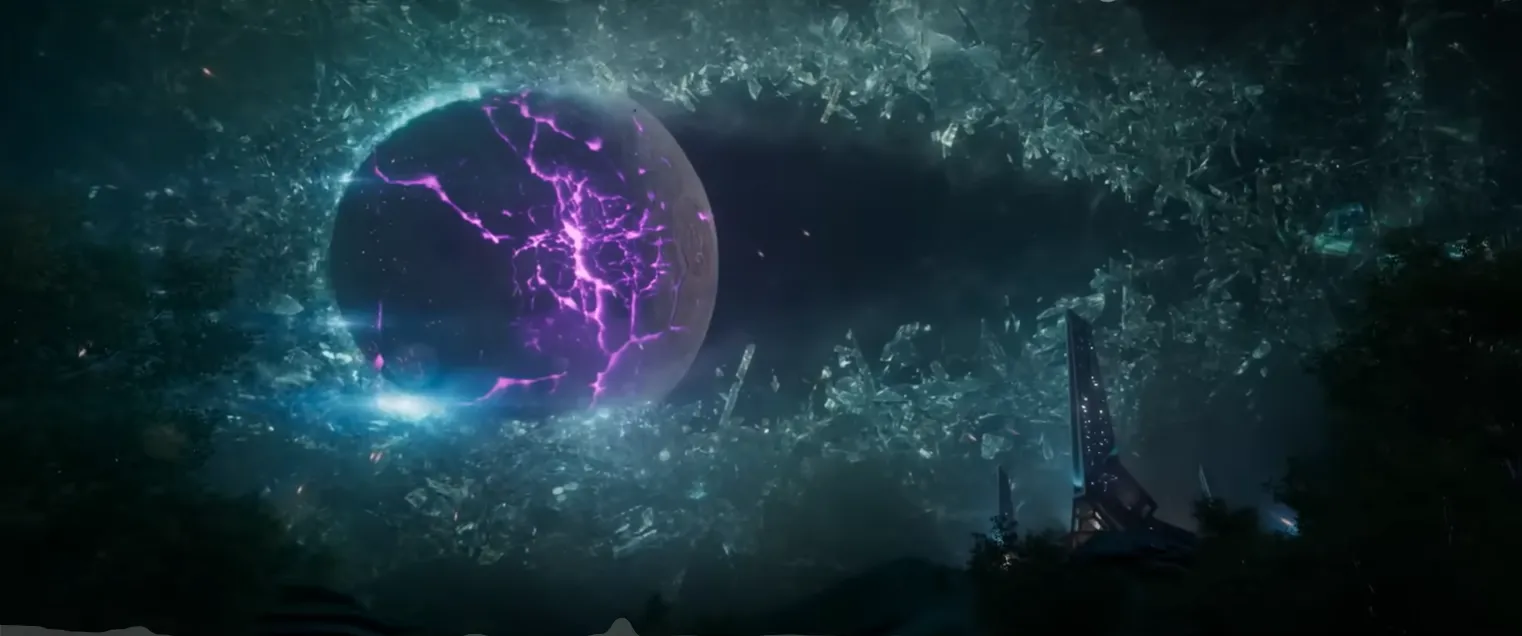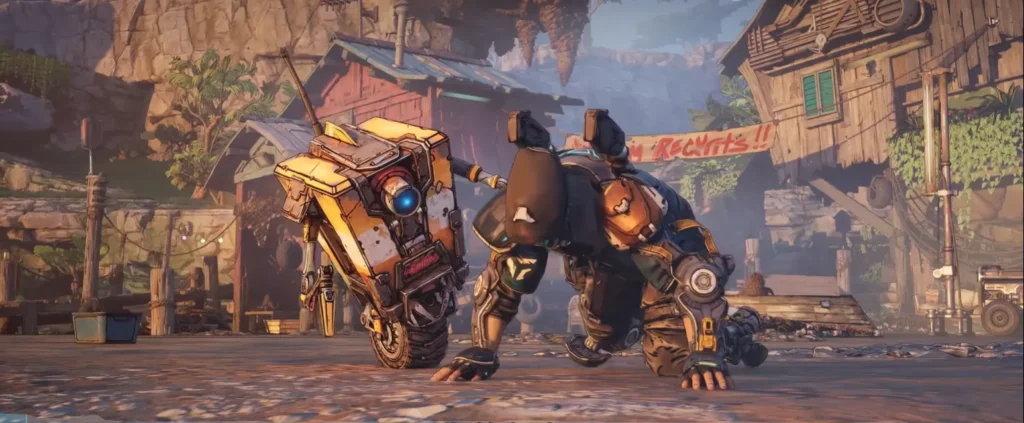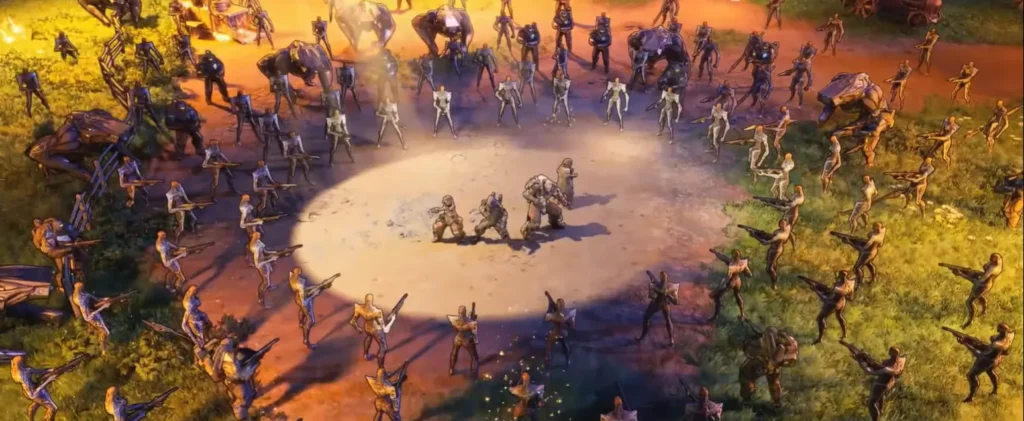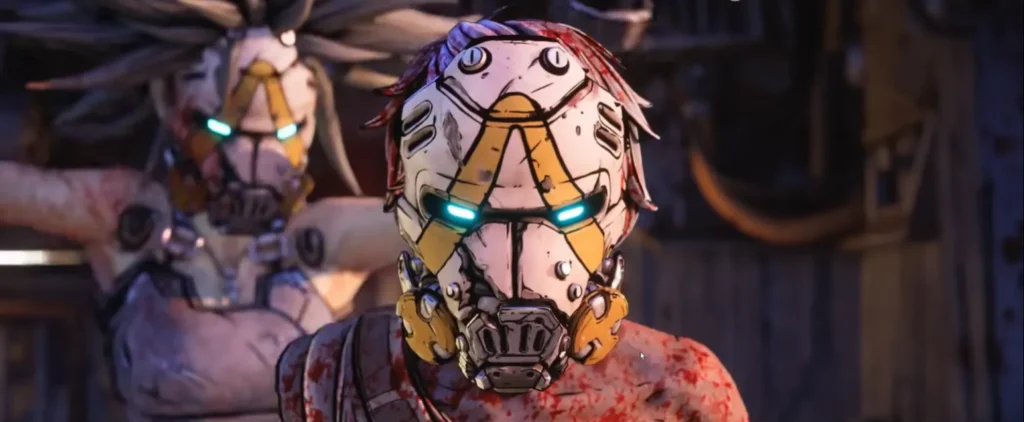Kontakt Boss
Beeilen Sie sich nicht, es abzuschließen, sprechen Sie direkt mit unserem Chef, Sie werden eine Überraschung erleben.



1900+ Benutzer
Abgeschlossene Benutzerdienste

The memory of my high school summer vacation is as vivid as yesterday—a close friend and I fought side by side in the wilds of Pandora, he controlling the powerful “Dwarf” and me the nimble “Witch.”
Whether challenging invincible bosses, overcoming the arduous level 8 suppression challenge, or repeatedly grinding for equipment in the Dragon Castle dungeon, even spending five or six hours just for a top-tier Bee Shield—the exhilarating feeling made me truly experience the insane allure of loot-hunting shooters for the first time.
By the time we successfully climbed the OP8 difficulty level, Pandora had already become an irreplaceable “second home” to us.
Now, Borderlands 4 has returned with its signature off-kilter humor and exhilarating loot-hunting experience. The familiar, mischievous figure of the clown reappears, instantly transporting me back to that exciting summer.
This time, the massive planet of Kairos has appeared, bringing a fresh feel to the adventure with its unprecedentedly open environments and rich content.
No one expected Borderlands 4 to be so radically innovative. The sheer scale of its system and gameplay adjustments alone is the most extensive in the series.
In a world where many renowned IPs are either blindly transitioning or frequently failing, maintaining the classic spirit of a series is a significant challenge for sequels.
But for Gearbox, simply being “acceptable” isn’t enough; they want Borderlands 4 to shine in the hearts of players truly.

The most noticeable change in Borderlands 4 is the introduction of a seamless map design—aside from a few key missions with separate dungeons, there are no annoying loading screens throughout the entire game.
Initially, I was skeptical of this “large map” design: it’s 2025, and players no longer see a zero-loading open world as a “nice extra” but rather as a “basic quality.”
But after actually playing it, my perspective on Borderlands 4’s open world has completely changed.
Players familiar with the Borderlands series are well aware that while previous games had similar open-world features, they were essentially just scattered level instances spread out across a large, flat map.
Aside from specific vehicle-based levels, the player’s exploration process remained largely the same: driving to a target point and then lighting a resurrection beacon, a mechanical and tedious process. Subsequent games have even gradually reduced the role of vehicles, sometimes eliminating them.
Borderlands 4’s open world has achieved a qualitative leap—it’s more in line with the current mainstream “new concept open world,” boasting not only an extremely high content density but also a wealth of hand-crafted details.
Rather than calling it an “open map,” it’s more like a massive battle arena composed of countless meticulously designed dungeons, cleverly stitched together through the terrain.
In experience, Borderlands 4’s combat intensity is no less intense than that of linear levels or traditional area maps, and the intensity can even be higher if the player takes the initiative.
GearBox has peppered the map with numerous encounter nodes, each with a weapon crate reward, effectively increasing the frequency of players’ “lottery” for equipment.
More importantly, once you become familiar with the new vehicle system and aerial maneuvering, exploring the large map becomes incredibly enriching: efficient and fluid movement is a joy in itself—vehicles can be summoned and canceled at will, allowing players to quickly switch between combat states and, using vehicle acceleration and gliding, cover vast distances in one go.
This increased mobility actually reduces the visual distance of the map, making the already densely packed map events even more accessible.
For loot-driven games, mastering the pacing of combat and loot is crucial. Compared to traditional FPS games, top-down “Diablo”-style games are often more adept at creating the flow of “grinding for loot.”
Borderlands 4’s large open map, with its randomly spawning elite bosses, numerous encounters, and high mobility that enhances combat efficiency, perfectly replicates the immersive “Diablo”-style grinding experience.
Even more thoughtfully, in addition to random events, most fixed quest bosses on the map can be challenged repeatedly directly at the boss’s door, consuming gold and erythrium.
Players can even repeatedly spawn the final boss of a quest, just like they would spawn monsters. This is a stark departure from the traditional linear experience of only setting high rewards in the final weapon chest.
The direct effect of this design is that it makes it easier for players to immerse themselves in the game. This is the first time in my review that I couldn’t help but think of the game’s endgame content when introducing maps and levels – this is exactly what GearBox has succeeded in: they made a loot-heavy game based on a single-player system, without the need for “climbing the leaderboard”, into a game that allows players to willingly and efficiently and fulfillingly repeat the core action of “grinding”.
Remarkably, Gearbox didn’t overdo the pursuit of “bigness”; instead, they further strengthened the core premise of the “Vault Hunter” game: players must actively search for Vault Fragments across the map, gather them, open the Vault Portal, and ultimately defeat the Vault Guardian within.
It’s worth noting that in previous games, Vault Guardians were often just “one-time bosses” in the storyline, but in Borderlands 4, they’ve become a crucial part of the player’s gear-hunting process.
These designs clearly demonstrate Borderlands 4’s dedication to filling its vast map with repetitive, grindy content.
The ultimate goal is to optimize the end-game experience—to ensure that, even after completing the main storyline, players are still willing to pull the trigger thousands of times, rediscovering their initial passion and love for the game, even if their hair thins and their liver becomes sclerotic.

Of course, if the initial experience isn’t great, even the richest end-game content won’t retain players. After playing Borderlands 4 for seven consecutive days, my experience is this: the system changes are truly revolutionary!
Overall, Borderlands 4 further decouples the development system, significantly increasing player choice. Take the health pack, for example. It not only restores health but also comes with various additional benefits—such as increased fire rate and damage reduction—allowing players to interact more closely with the battlefield.
In addition, the game has added firmware entries similar to “suits”: the four equipment slots, except weapons, may all produce firmware entries. Collecting different numbers of entries can activate “one to three layers” of suit benefits, which undoubtedly adds another dimension to the “content that can be brushed”.
The increased controllable content in the game is just superficial; the core benefit lies in the significantly expanded player equipment build space.
Some might think that for an FPS game to have four equipment slots is a bit redundant.
But in my experience, the addition of additional development dimensions like firmware has effectively solved the series’ long-standing “bullet sponge” problem—a key obstacle that has hindered many developers from entering the FPS loot-grabbing genre.
After all, there’s a natural conflict between the numerically driven experience of RPGs and the “kill whoever you want” exhilaration of FPS games.
Previous Borderlands games relied on “building core gear and then overwhelming the enemy with stats” to alleviate the frustration of “locking in a volley of attacks, only to have the enemy remain standing” (“until you’re locked in a volley of attacks”).
However, due to the series’ inherent “true randomness,” players weren’t guaranteed to obtain their desired core gear. Coupled with the lack of skill points in the early game, which prevented them from building a complete core build, the frustration was particularly intense, forcing them to rely on slowly leveling up and upgrading their equipment to “get through it.”
Borderlands 4 has largely mitigated the stat curve issue. During my week of play, I barely encountered a bullet sponge. On the contrary, by forgoing defense and focusing on attack, I was able to quickly clear the main storyline with an extreme build, even at a lower dynamic level.
This brings us to another core feature of the game’s stat progression: the “accessorization” of guns, or rather, the “de-stating” of guns.
It might sound like a no-brainer, but anyone who’s played the series (especially Tiny Tina’s Land of Fantasy) will understand: the guns in Borderlands before were more like “fire sticks that cast magic” than “guns.”
Different “fire sticks” had different enchantments, some with faster fire rates and higher damage, and were labeled with specific stat improvements—for example, “56.7% faster than another.”
There are two obvious problems with this design: first, the gun special effects are too fancy, which weakens the fun of “shooting itself”; second, it creates a habit of overly focusing on weapons, causing players to have to frequently change weapons to keep up with the increase in build strength.
The first point is easy to understand, but the “pain” of the second is more personal.
Every FPS player has their own “gun preferences”—for example, I prefer high-powered, single-shot weapons like snipers, shotguns, and revolvers, and have no interest in the “splashing” of submachine guns. Therefore, in Borderlands 1, 2, and 3, I’ve always preferred Accord brand guns.
However, under the settings of the previous games, if you drew an SMG with excellent attributes, even if you didn’t like it, you had to reluctantly replace your Accord revolver—after all, the stat difference was there.

I’ve always believed that players aren’t limited to just one “stance” for shooting, but the initiative to develop new stances should be in the players’ hands, rather than the game forcing them to change their guns. This frustrating feeling of being forced to change your gameplay has almost disappeared in Borderlands 4.
Now, I choose my weapons based entirely on brand, accessories, and firing mode—in other words, it’s all about feel. A shotgun, a sniper rifle, and two Accords saw me through the entire game.
It doesn’t matter if I don’t find high-level weapons of the same type along the way, because the key to stat development lies in accessories. Even with low-level guns, combat is relatively easy, and I often even do my damage.
Of course, the advantages of gun accessorization extend beyond the high-damage Accord series. It’s equally beneficial for players who prefer rapid-fire weapons or those who prefer a “blast-and-bomb” style—in other words, it can satisfy any player with a dedicated “gun play” style.
Honestly, the “liberalization of gun choice” alone is enough for me to give Borderlands 4 a high score.
Seeing this, you might ask: If guns don’t have numerical differences in their entries, will the gameplay become more similar?
After all, Gearbox always says that their games have “billions of different guns”, but there are only a few common combinations that are actually useful.
This problem does exist, and it’s especially noticeable in the early stages of the game. Because the number of weapon attachments increases with level, early weapons often have only one attachment, or even no attachments at all.
Coupled with the fact that attribute value differences have been removed, the experience of playing different weapons is largely the same, resulting in me feeling almost no need to regularly upgrade my regular weapons in the early stages.
However, while this refers to “regular weapons,” “Golden Legends” (legendary-quality weapons) are a different story.
Legendary weapons come with special attributes that completely change how they’re used. Unfortunately, I was nearly finished with the game when I got my first legendary weapon.
Some legendary weapons offer truly creative attack methods—for example, the Order Legendary Sniper Rifle I obtained can fire while charging, delivering “rapid damage,” completely overcoming my preconceived notion that Order weapons deal slow damage.
Sadly, this gun was quickly discarded—because I found a sniper rifle with incredibly high single-shot damage, even with a “hand-cranked machine gun grip” that allowed for 24 rounds of high damage, practically annihilating elite monsters and bosses with a single click.
This is just a trivial example, but it illustrates that the later stages of the game offer a richer variety of gadgets and fire modes, making it easy to find surprises. This “chemical reaction” created by combining different gadgets and fire modes is far more interesting than simply stacking stats.
Even after reaching the endgame, I’ve only seen a handful of Legendary gear, let alone completing all the secondary modes and accessory combinations—a near-impossible feat.
Until now, I can only say I’ve “completed Borderlands 4’s main storyline” and completed the game’s one-shot content. The vast amount of endgame content that follows, filled with unknowns and possibilities, is impossible to predict or exhaust.
When it comes to gun diversity, GearBox has always boasted of being second in the industry, with no one claiming first. Borderlands 4 further refines this advantage, making the “weirdness” of even the most unusual guns even more meaningful.
Of course, this design also comes with trade-offs: whether players can accept using “simple” guns early on has become a key dividing point in their evaluations of the game.
As for the “exact length” of the early game—unfortunately, in my experience, it’s quite long for the entire series, taking nearly 30 hours even to complete just the main story.
However, Gearbox has clearly considered this: once you complete the main story on a single character and unlock the replayable endgame content like the Hunter Mastery and Ultimate Vault Hunter Challenge, you can create a level 30 character, skipping the early game and directly experiencing the later stages of each character’s gameplay.
Furthermore, as you progress through the main storyline, you might need to complete additional side quests to gain experience due to the “dynamic leveling” feature; otherwise, the level gap will make your character particularly vulnerable.
But for me, Borderlands 4’s side quests never felt like tedious “job”—the key lies in Gearbox’s creative writers’ unique ideas, especially the side quests, which are full of wildly creative ideas. I won’t go into any examples here, as spoilers would ruin the experience.
However, the compelling storytelling of some of the side quests makes the newly added “dynamic weather system” seem a bit cumbersome.
This is because many scenes display drastically differently in different lighting conditions—for example, the “fireworks scene” is completely invisible during the day, and Gearbox hasn’t designed a function to automatically fast-forward specific missions.
Frankly, this feels a bit lazy, or perhaps due to the team’s lack of experience in this first open-world venture. After all, aside from a few developers who excel at open-world development, creating an open world for the first time presents significant technical challenges for most teams.
Fortunately, this isn’t a serious problem. Compared to the frustrating experience of S.T.A.L.K.E.R. 2: Heart of Chornobyl, which forced players to explore the scenery in the dark during the main storyline, Borderlands 4 at least doesn’t make this kind of low-level mistake.
Compared to the exciting side quests, Borderlands 4’s main storyline feels rather conventional—a typical “old-fashioned” narrative of freedom and democracy. But “conventional” doesn’t necessarily mean “bad,” as it avoids the common pitfalls of many current games.
In recent years, many games have favored plots centered around “new generation characters,” only to find the new characters unlikable and the older characters discarded as mere tools, sparking widespread discontent within the fan community. But I can guarantee you this: Borderlands 4 will not feature such plots.
There are many famous scenes of “burning money” in the main mission. If you don’t have high requirements for the gameplay, this game is also worth experiencing just to watch the plot and interact with those old friends who have “reunited after a long time” (mainly classic characters that have not been killed by Gearbox).
Overall, “Borderlands 4” is indeed worthy of the evaluation of “shining brilliantly” – even if the “large map” and “gameplay innovation” are separated, it has also handed in a full score answer sheet; even if some people are not impressed by some of the “innovations”, it at least achieved “large scale and good experience”.
As mentioned at the outset, for a legacy IP of Borderlands’ magnitude, maintaining the series’ core spirit and avoiding a major setback is a success in itself.
GearBox clearly didn’t stop there: rather than becoming a “conservative old guard,” they delivered a series of clever optimizations, many of which offer valuable insights for the entire “FPS loot-hunting” genre.
In contrast, superficial innovations like “seamless maps” and “air-based boss battles” seem like icing on the cake.
If you are a fan of the Borderlands series or a player who likes loot-shooting games, “Borderlands 4” is definitely worth investing dozens of hours to experience the passion and carnival on the planet Kairos.